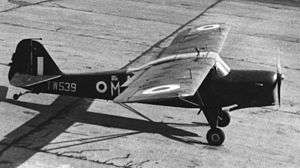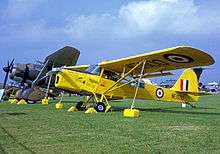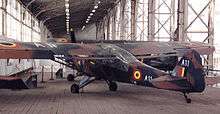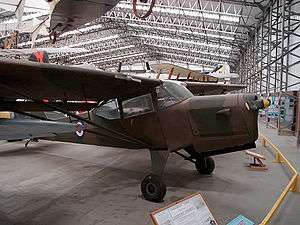Auster AOP.6
| Auster AOP.6 | |
|---|---|
 | |
| Auster AOP.6 operational with 663 (AOP) Squadron in 1954 | |
| Role | observation aircraft |
| Manufacturer | Auster Aircraft Limited |
| Introduction | 1945 |
| Primary users | Royal Air Force Belgian Air Force |
| Number built | approx 400 |
| Developed from | Taylorcraft Auster |
| Variants | Beagle A.61 Terrier Auster Tugmaster |
The Auster AOP.6 was a British military air observation aircraft produced by Auster Aircraft Limited to replace the numerous wartime Taylorcraft Auster aircraft then in-service.
History
The Auster AOP.6 (Auster Model K) was designed as a successor to the Taylorcraft Auster V, it had a strengthened fuselage, increased all-up weight and a 145 hp (108 kW) de Havilland Gipsy Major 7 engine. It had a different appearance to the wartime Austers due to the lengthened landing gear struts (due to the larger propeller), and external non-retractable aerofoil flaps.

An initial production run of 296 were completed for the Royal Air Force in 1949. A second batch was produced from 1952 with a total delivered of around 400. Some aircraft ordered by the Royal Air Force aircraft were diverted to the Belgian Air Force (22) and the Royal Hong Kong Auxiliary Air Force (2). New aircraft were delivered to Royal Canadian Air Force, South African Air Force, and the Arab Legion Air Force (Jordan).

A dual-control training version of the AOP.6 was produced, 77 serving as the Auster T.7 (Auster Model Q). These flew alongside the AOP.6 in the AOP squadrons.
In 1955 two T.7 aircraft were modified for use on the 1956 Commonwealth Trans-Antarctic Expedition, being designated Auster Antarctic (Auster Model C4). The aircraft had extra radio equipment, larger tail surfaces, the ability to be fitted with floats or skis as required and a bright yellow finish to increase visibility against the snow and ice.
The aircraft was gradually replaced with the Auster AOP.9 from 1955 and surplus aircraft were converted to civilian use, first as the Auster 6A and later as the Beagle A.61 Terrier.
Variants
- Auster AOP.6 - main production version, over 400 built.
- Auster 6A Tugmaster - former military aircraft converted for civil use
- Auster T.7 - dual-control training version of the AOP.6, 77 built.
- Auster T.7 Antarctic - modified aircraft for use in the Antarctic, two conversions.
- Auster AOP.8 - proposed development, not built.[1]
- Auster T.10 - AOP.6s converted to T7 standard, 10 conversions.
- Beagle A.61 Terrier - former military aircraft converted for civil use
- Auster S - An AOP aircraft based on the Auster 6, with enlarged tail. Prototype only.
- Marshalls MA.4 - An Auster T7 modified by Marshalls of Cambridge with a new wing and larger tailplane. Perforated holes in the wing, ailerons and flaps were connected to a suction pump driven by an auxiliary gas turbine engine in the fuselage. The aircraft was used for research into boundary layer control. Serial VF665, it lost control and crashed on 8 March 1966 in Suffolk killing both crew.
Operators
Military operators
- Royal Australian Air Force (Two AOP.6 aircraft only).

- Belgian Army (AOP.6)
- Belgian Air Force (AOP.6)
- Burma Air Force (T.7)
- Royal Canadian Air Force (AOP.6 and T.7)
- Arab Legion (AOP.6 and T.7)
- Royal Jordanian Air Force

- Royal New Zealand Air Force - One Auster T.7c was used by the RNZAF for the 1956 Commonwealth Trans-Antarctic Expedition.
- Pakistan Air Force (AOP.6)
- Pakistan Army (AOP.6)
- Pakistan Army Aviation Corps - Ex-Pakistan Air Force aircraft.
- South African Air Force (AOP.6)

- British Army
- Royal Air Force (AOP.6 and T.7)
- No. 8 Squadron RAF
- No. 209 Squadron RAF
- No. 267 Squadron RAF
- No. 651 Squadron RAF
- No. 652 Squadron RAF
- No. 656 Squadron RAF
- No. 657 Squadron RAF
- No. 659 Squadron RAF
- No. 661 Squadron RAF
- No. 662 Squadron RAF
- No. 663 Squadron RAF
- No. 664 Squadron RAF
- No. 666 Squadron RAF
- No. 227 Operational Conversion Unit RAF
Specifications (AOP.6)
Data from Green:[2]

General characteristics
- Crew: 2
- Length: 23 ft 9 in (7.24 m)
- Wingspan: 36 ft (10.97 m)
- Height: 8 ft 4½ in (2.55 m)
- Wing area: 184 ft² (17.09 m²)
- Empty weight: 1,413 lb (641 kg)
- Max. takeoff weight: 2,160 lb (980 kg)
- Powerplant: 1 × de Havilland Gipsy Major 7 inline piston, 145 hp (108 kw)
Performance
- Maximum speed: 124 mph (200 km/h)
- Range: 315 miles (507 km)
- Service ceiling: 14,000 ft (4,265 m)
- Rate of climb: 810 ft per minute (4 m/s)
See also
- Related development
References
Notes
- ↑ Auster A.O.P.8 Flight 3 March 1949 p. 266
- ↑ Green 1964, p. 48.
Bibliography
- Green, William (1964). Macdonald Aircraft Handbook. London: Macdonald & Co. (Publishers) Ltd.
- The Illustrated Encyclopedia of Aircraft (Part Work 1982-1985). Orbis Publishing.
- Jackson, A.J. (1974). British Civil Aircraft since 1919 Volume 1. London: Putnam. ISBN 0-370-10006-9.
- Halley, J.J., The Squadrons of the Royal Air Force & Commonwealth 1918-1988, Air-Britain, Tonbridge, ISBN 0-85130-164-9.
External links
![]() Media related to Auster AOP.6 at Wikimedia Commons
Media related to Auster AOP.6 at Wikimedia Commons